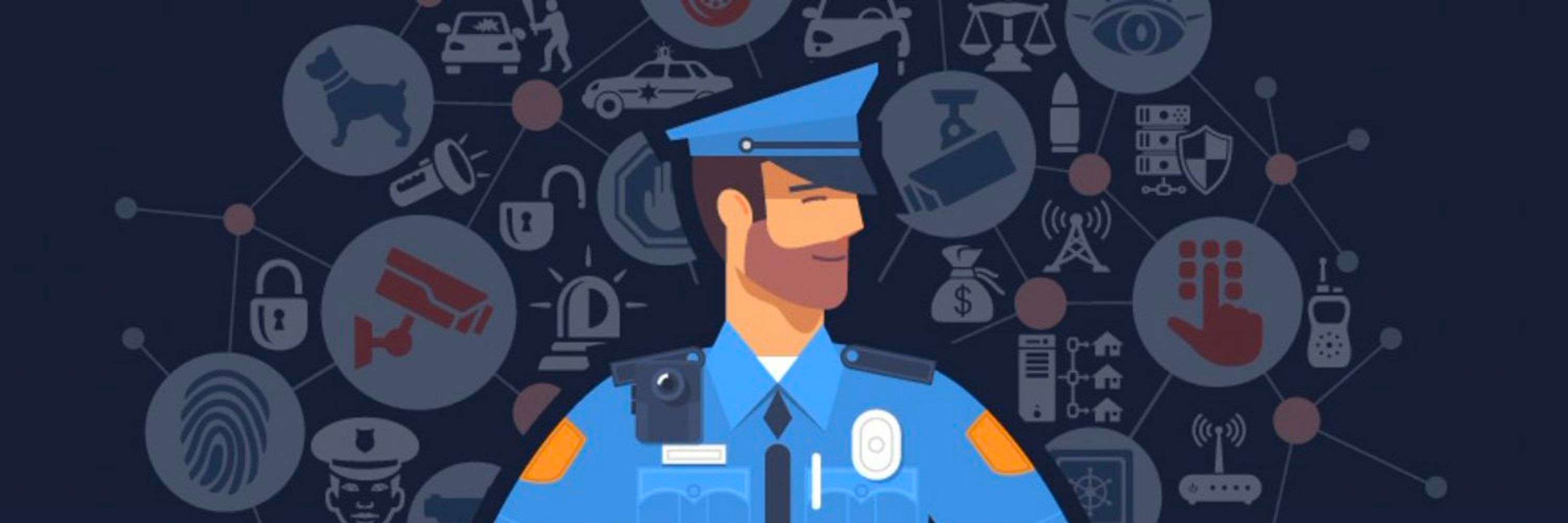
Daniel S Lawrence
@danslawrence.bsky.social
PhD Senior Research Scientist at the CNA Corporation. I study many topics on policing. Opinions all mine.
x(at)cna.org, x=lawrenced
Previously at the Urban Institute & RTI International
x(at)cna.org, x=lawrenced
Previously at the Urban Institute & RTI International
I won’t bore you with the details, but the study conducted a scoping review of the literature, identifying 41 publications across 34 different studies that focused on one of the four types of LEICs.



March 18, 2025 at 2:22 PM
I won’t bore you with the details, but the study conducted a scoping review of the literature, identifying 41 publications across 34 different studies that focused on one of the four types of LEICs.
Real-time crime centers (RTCC), which provide real-time information to officers responding to crime incidents and offer retroactive investigative support; and crime information centers (CIC), the newest LEIC, which share some similarities with RTCCs but are distinct in 2 ways:

March 18, 2025 at 2:22 PM
Real-time crime centers (RTCC), which provide real-time information to officers responding to crime incidents and offer retroactive investigative support; and crime information centers (CIC), the newest LEIC, which share some similarities with RTCCs but are distinct in 2 ways:
We identified four types of LEICs, which are all used by law enforcement agencies across the country. They include fusion centers, which focus on counter terrorism efforts; crime gun intelligence centers (CGICs), which focus on firearm investigations and forensics; …

March 18, 2025 at 2:22 PM
We identified four types of LEICs, which are all used by law enforcement agencies across the country. They include fusion centers, which focus on counter terrorism efforts; crime gun intelligence centers (CGICs), which focus on firearm investigations and forensics; …
I’m particularly excited for this one, as I feel it’ll help move the field in the right direction. Our NEW study defines and reviews the literature associated with law enforcement intelligence centers (LEICs). The main takeaway: These centers need to be studied more!

March 18, 2025 at 2:22 PM
I’m particularly excited for this one, as I feel it’ll help move the field in the right direction. Our NEW study defines and reviews the literature associated with law enforcement intelligence centers (LEICs). The main takeaway: These centers need to be studied more!
But only agency size remained a significant factor once the psychological metrics were added. And the leading aspects predicting suicidal ideation were, perhaps not surprisingly, poor mental health and being positive for post-traumatic stress disorder.
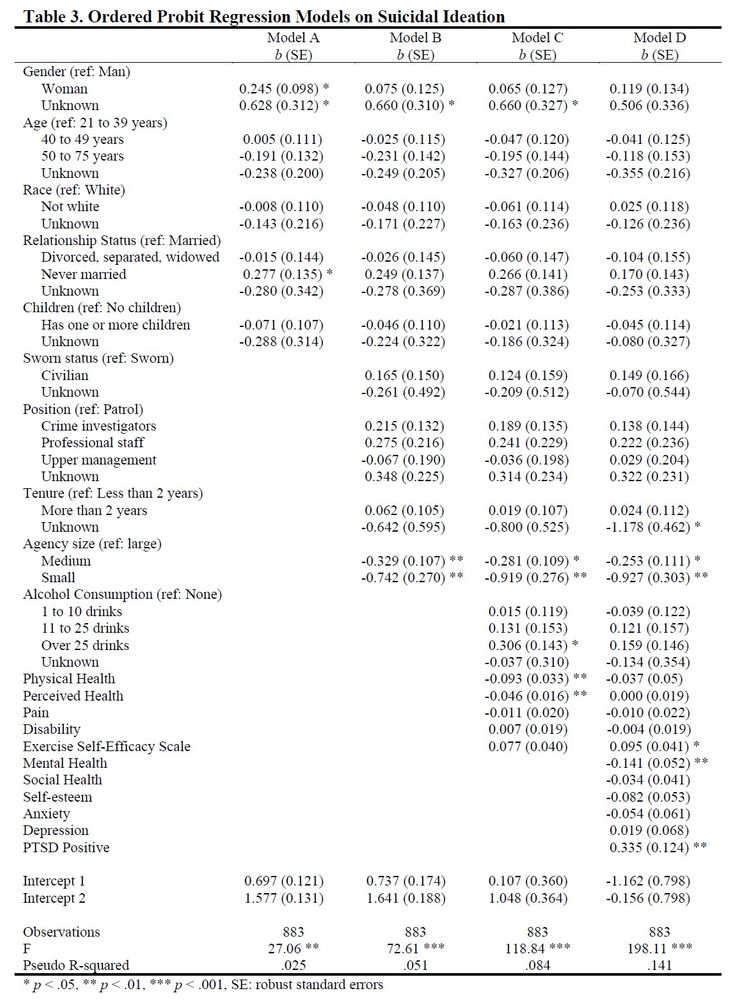
March 10, 2025 at 1:29 PM
But only agency size remained a significant factor once the psychological metrics were added. And the leading aspects predicting suicidal ideation were, perhaps not surprisingly, poor mental health and being positive for post-traumatic stress disorder.
Apologies for the big regression table but I wanted to show the full model that sequentially adds domains. Prior to including the psychological metrics, sex, relationship status, agency size, alcohol consumption, and physical health were all factors predicting suicidal ideation.

March 10, 2025 at 1:29 PM
Apologies for the big regression table but I wanted to show the full model that sequentially adds domains. Prior to including the psychological metrics, sex, relationship status, agency size, alcohol consumption, and physical health were all factors predicting suicidal ideation.
This study examined survey data among 883 police staff across 8 agencies. We analyzed how demographic and position characteristics, physical wellbeing, and psychological health predict ideation. Then we explored the relationships between mental health, PTSD, and suicidal ideation.

March 10, 2025 at 1:29 PM
This study examined survey data among 883 police staff across 8 agencies. We analyzed how demographic and position characteristics, physical wellbeing, and psychological health predict ideation. Then we explored the relationships between mental health, PTSD, and suicidal ideation.
NEW study examining suicidal ideation among law enforcement officers. The big (not surprising) takeaway: improving mental health and responses to PTSD are critical aspects to preventing suicide among this population. More details in thread and links at the end.

March 10, 2025 at 1:29 PM
NEW study examining suicidal ideation among law enforcement officers. The big (not surprising) takeaway: improving mental health and responses to PTSD are critical aspects to preventing suicide among this population. More details in thread and links at the end.
Just hit a milestone: over 1,000 citations of my research! It's humbling to know that my work is contributing to meaningful conversations in the criminal justice field. Grateful for every collaborator, reviewer, and reader. Check out daniel-s-lawrence.com for more info about me.
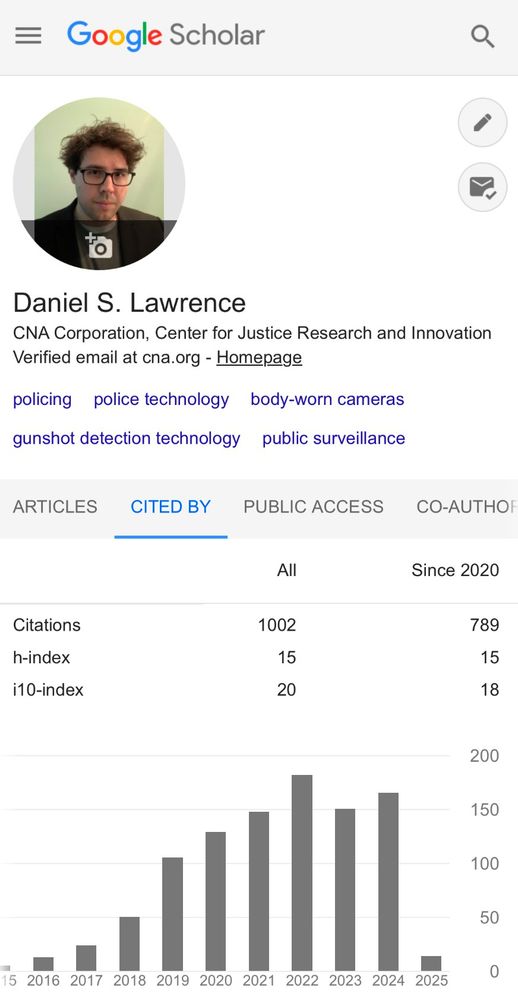
February 3, 2025 at 1:31 PM
Just hit a milestone: over 1,000 citations of my research! It's humbling to know that my work is contributing to meaningful conversations in the criminal justice field. Grateful for every collaborator, reviewer, and reader. Check out daniel-s-lawrence.com for more info about me.
The Mountain division in the West region and the New England division in the Northeast had the highest rates, at 29.3 and 34.6 deaths per 100,000, respectively. We go into detail on some of the reason we’re observing these geographical differences.
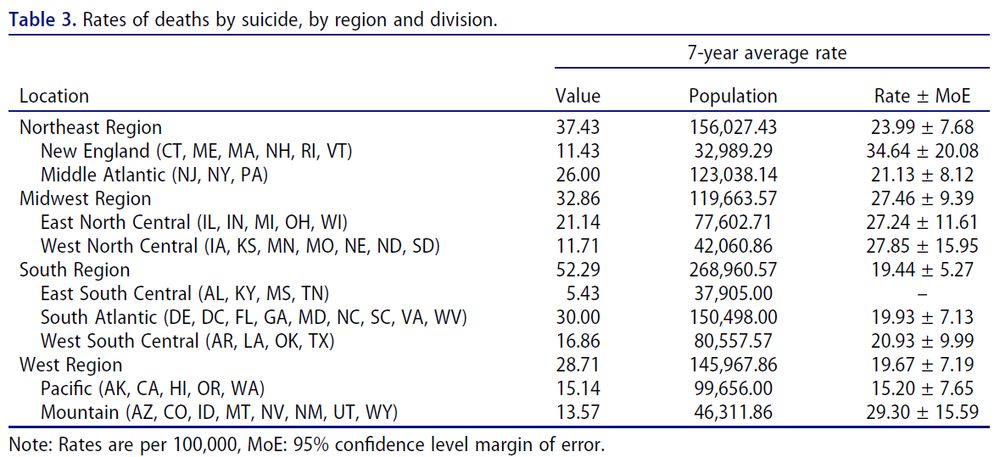
January 22, 2025 at 3:48 PM
The Mountain division in the West region and the New England division in the Northeast had the highest rates, at 29.3 and 34.6 deaths per 100,000, respectively. We go into detail on some of the reason we’re observing these geographical differences.
By region, the South had the highest number of deaths by suicide but also has the largest population of law enforcement officers, resulting in the lowest average suicide rate, at 19.4. The West region had a similar rate, while both the Northeast and Midwest were more elevated.

January 22, 2025 at 3:48 PM
By region, the South had the highest number of deaths by suicide but also has the largest population of law enforcement officers, resulting in the lowest average suicide rate, at 19.4. The West region had a similar rate, while both the Northeast and Midwest were more elevated.
Between 2016 and 2022, male personnel had higher suicide rates (20.4–28.5, avg. 22.7) than females, who averaged 12.7—roughly half. Despite males outnumbering females roughly by 7:1 among sworn staff, the disparity in suicide rates highlights significant gender differences in outcomes.

January 22, 2025 at 3:48 PM
Between 2016 and 2022, male personnel had higher suicide rates (20.4–28.5, avg. 22.7) than females, who averaged 12.7—roughly half. Despite males outnumbering females roughly by 7:1 among sworn staff, the disparity in suicide rates highlights significant gender differences in outcomes.
Our analysis estimates a police suicide rate ranging between 19.0 and 27.5, with an average rate of approximately 21.4 over the seven years studied. The average number of suicides per year during this period was 151.3, with a low of 128 in 2017 and a high of 196 in 2019.
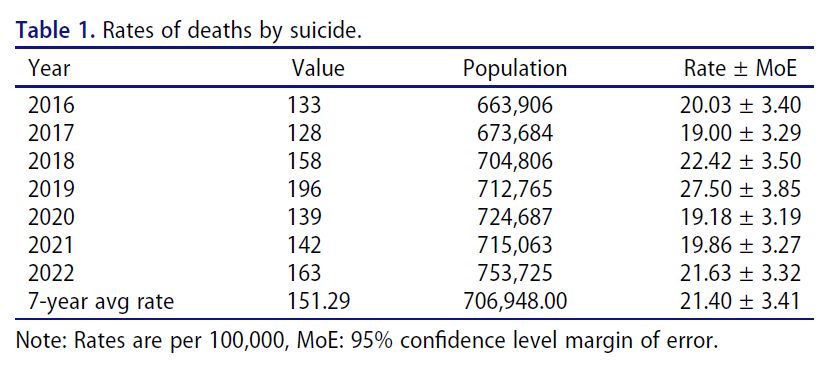
January 22, 2025 at 3:48 PM
Our analysis estimates a police suicide rate ranging between 19.0 and 27.5, with an average rate of approximately 21.4 over the seven years studied. The average number of suicides per year during this period was 151.3, with a low of 128 in 2017 and a high of 196 in 2019.
While going through these rates, keep in mind that the national suicide rate for the general population of 10 years and older is 14.0 in 2021. (Although that’s not a great comparison, considering officers are typically 21 and older.)
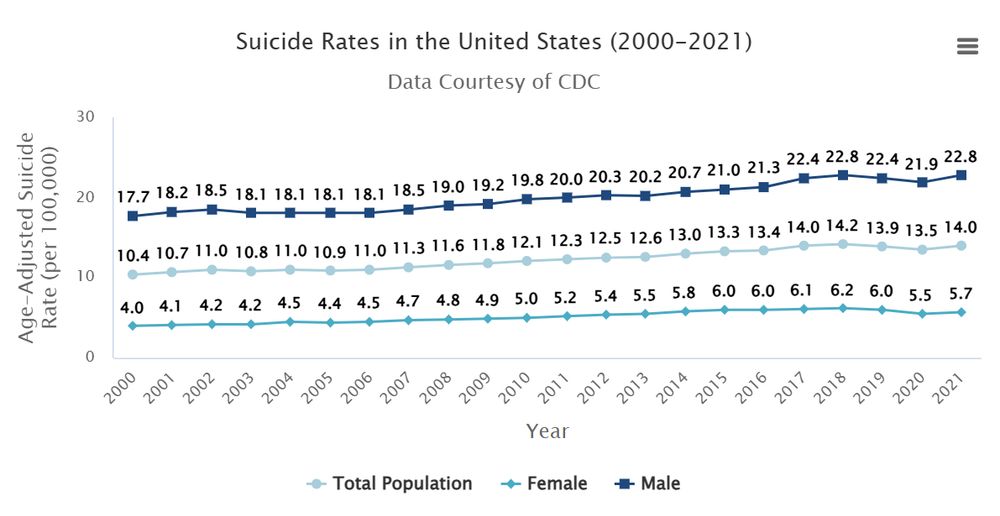
January 22, 2025 at 3:48 PM
While going through these rates, keep in mind that the national suicide rate for the general population of 10 years and older is 14.0 in 2021. (Although that’s not a great comparison, considering officers are typically 21 and older.)
NEW study examining suicide rates among sworn law enforcement officers from 2016 to 2022, disaggregated by year, sex, and geographic region and division. Links to article at end.

January 22, 2025 at 3:48 PM
NEW study examining suicide rates among sworn law enforcement officers from 2016 to 2022, disaggregated by year, sex, and geographic region and division. Links to article at end.
Events with higher BWC activation rates often involved direct interactions, like advising, citing, detaining, arresting, or domestic violence cases. These had higher activation rates compared to events disposed as filed, pending, other, or unfounded.

November 25, 2024 at 2:34 PM
Events with higher BWC activation rates often involved direct interactions, like advising, citing, detaining, arresting, or domestic violence cases. These had higher activation rates compared to events disposed as filed, pending, other, or unfounded.
Among calls for service, officers were more likely to activate BWCs during calls involving crimes against persons compared to other crimes or non-criminal incidents. Activation was more frequent during traffic stops than other self-initiated activities.

November 25, 2024 at 2:34 PM
Among calls for service, officers were more likely to activate BWCs during calls involving crimes against persons compared to other crimes or non-criminal incidents. Activation was more frequent during traffic stops than other self-initiated activities.
Results indicate that BWC activations occurred in about 43% of events, overall. This may seem low, but other studies have found similar amounts at this stage of a BWC program. Self-initiated events (44%) had slightly higher activation levels compared to calls for service (42%).

November 25, 2024 at 2:34 PM
Results indicate that BWC activations occurred in about 43% of events, overall. This may seem low, but other studies have found similar amounts at this stage of a BWC program. Self-initiated events (44%) had slightly higher activation levels compared to calls for service (42%).
NEW study on how various individual and event-level factors influence police officers’ decision to activate their body-worn cameras (BWCs) across both community member-initiated services and officer-initiated activities. Links to article at end.

November 25, 2024 at 2:34 PM
NEW study on how various individual and event-level factors influence police officers’ decision to activate their body-worn cameras (BWCs) across both community member-initiated services and officer-initiated activities. Links to article at end.
Response time: Overall, officers responded to GDT alerts faster than they do to 911 calls; however, the time savings mainly comes from the GDT automation to assign officers, rather than the actual time taken by the officer to arrive at the scene after being assigned to the event.

November 18, 2024 at 1:21 PM
Response time: Overall, officers responded to GDT alerts faster than they do to 911 calls; however, the time savings mainly comes from the GDT automation to assign officers, rather than the actual time taken by the officer to arrive at the scene after being assigned to the event.
Workload: The increased notifications led to a corresponding increase in the total time to respond to those calls, ranging from 1.8 to 3.4 times greater across the examined areas. Officers had to allocate more time to respond to the notifications, reflecting an expanded workload.

November 18, 2024 at 1:21 PM
Workload: The increased notifications led to a corresponding increase in the total time to respond to those calls, ranging from 1.8 to 3.4 times greater across the examined areas. Officers had to allocate more time to respond to the notifications, reflecting an expanded workload.
Notifications: The number of shootings reported to agencies, either from a GDT alert or 911 call, roughly doubled in areas covered by the technology following its 1st-year implementation. This was observed in all examined areas, ranging from a factor of 1.7 to 2.4 times.

November 18, 2024 at 1:21 PM
Notifications: The number of shootings reported to agencies, either from a GDT alert or 911 call, roughly doubled in areas covered by the technology following its 1st-year implementation. This was observed in all examined areas, ranging from a factor of 1.7 to 2.4 times.
We focus our analyses on three aspects: (1) how GDT affects the amount of shooting notifications a police agency experiences, (2) how GDT affects the overall officer workload to respond to those notifications, and (3) how GDT affects response time to individual calls.

November 18, 2024 at 1:21 PM
We focus our analyses on three aspects: (1) how GDT affects the amount of shooting notifications a police agency experiences, (2) how GDT affects the overall officer workload to respond to those notifications, and (3) how GDT affects response time to individual calls.
With support from NIJ in 2016 to 2019, the study team evaluated this GDT in Denver, CO, Milwaukee, WI, and Richmond, CA. As with many GDT programs, each of these cities had expanding GDT coverage over time, resulting in 8 unique areas, plus two analyses that combined areas.

November 18, 2024 at 1:21 PM
With support from NIJ in 2016 to 2019, the study team evaluated this GDT in Denver, CO, Milwaukee, WI, and Richmond, CA. As with many GDT programs, each of these cities had expanding GDT coverage over time, resulting in 8 unique areas, plus two analyses that combined areas.
Adding my first thread from my research to this new site. This comes from my most recent study on the gunshot detection technology, ShotSpotter, and the impact it has on notifying police departments of shooting events, officer workload, and response times.

November 18, 2024 at 1:21 PM
Adding my first thread from my research to this new site. This comes from my most recent study on the gunshot detection technology, ShotSpotter, and the impact it has on notifying police departments of shooting events, officer workload, and response times.

